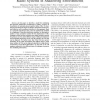Free Online Productivity Tools
i2Speak
i2Symbol
i2OCR
iTex2Img
iWeb2Print
iWeb2Shot
i2Type
iPdf2Split
iPdf2Merge
i2Bopomofo
i2Arabic
i2Style
i2Image
i2PDF
iLatex2Rtf
Sci2ools
ICC
2009
IEEE
2009
IEEE
Interference and Deployment Issues for Cognitive Radio Systems in Shadowing Environments
In this paper we describe a model for calculating the aggregate interference encountered by primary receivers in the presence of randomly placed cognitive radios (CRs). We show that incorporating the impact of distance attenuation and lognormal fading on each constituent interferer in the aggregate, leads to a composite interference that cannot be satisfactorily modeled by a lognormal. Using the interference statistics we determine a number of key parameters needed for the deployment of CRs. Examples of these are the exclusion zone radius, needed to protect the primary receiver under different types of fading environments and acceptable interference levels, and the numbers of CRs that can be deployed. We further show that if the CRs have apriori knowledge of the radio environment map (REM), then a much larger number of CRs can be deployed especially in a high density environment. Given REM information, we also look at the CR numbers achieved by two different types of techniques to proc...
Acceptable Interference Levels | Communications | Exclusion Zone Radius | ICC 2009 | Primary Receiver |
| Added | 18 Feb 2011 |
| Updated | 18 Feb 2011 |
| Type | Journal |
| Year | 2009 |
| Where | ICC |
| Authors | Muhammad Fainan Hanif, Mansoor Shafi, Peter J. Smith, Pawel A. Dmochowski |
Comments (0)

